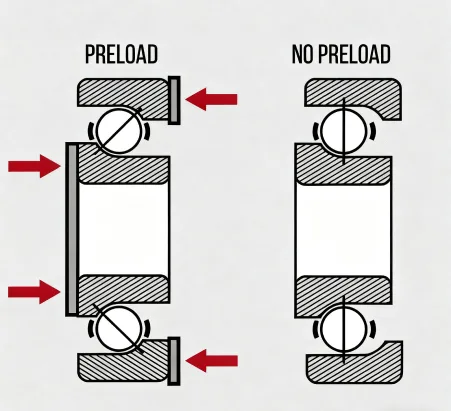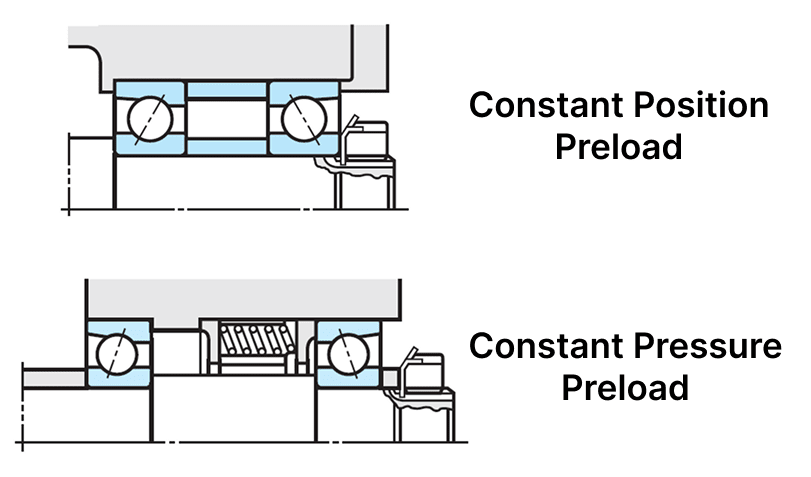Knowledge Center
From ‘Soft’ to ‘Stiff’: A Guide to Bearing Preload and System Rigidity Design
Imagine poking an object with a flexible rubber ruler versus a steel ruler. The rubber ruler will bend easily, while the steel ruler will transfer your force precisely. This ability to resist deformation is called rigidity (or stiffness).
In machine tools, robots, or precision measurement equipment, rigidity is paramount. A “soft” system will deform slightly under processing forces or loads, leading to inaccurate positioning and vibration marks, ultimately compromising product quality. A “stiff” system, however, remains rock-solid, ensuring every movement is precise and accurate. As the core component supporting rotation, the bearing’s rigidity directly defines the performance ceiling of the entire system.
Section Navigation
How to Choose the Right Bearing
- P0: The 8-Step Practical Guide to Systematic Bearing Selection
- C1: A Guide to Correctly Select a Bearing Type Based on Load, Direction, and Space
- C2: Bearing Arrangements: A Guide to Locating-Non-locating and Paired Mounting
- C3: How to Verify Bearing Size and Accurately Assess Its Lifespan
- C4: The Core of High-Precision: Balancing Speed, Precision, Fits, and Clearance
- C5: A Guide to Bearing Preload and System Rigidity Design
- C6: Choosing the Optimal Lubrication Strategy for Your Bearings
- C7: Key Design Points for Bearing-Related Components (Shaft, Housing, and Seals)
- C8: Smart Mounting and Efficient Dismounting of Bearings
The Core Concept: Bearing Preload
If a standard bearing has a certain base level of rigidity, then preload is an advanced technique that can dramatically increase that rigidity.Definition
Standard bearings have a tiny amount of internal “clearance” or “play.” Preload is the process of applying an internal axial force to a bearing before any external operating loads are applied. This is done to completely eliminate the clearance, forcing the rolling elements and raceways into a state of constant, intimate contact.
Purpose
Why do this? Preloading provides four key advantages:- Increased System Rigidity: With no clearance, the shaft assembly will have almost no displacement due to clearance take-up when a load is applied. The system becomes much “stiffer.”
- Improved Rotational Accuracy: It reduces shaft wobble and vibration during rotation, leading to a more stable running track.
- Reduced Noise and Vibration: It prevents rolling elements from sliding or rattling in the unloaded zone, resulting in smoother operation.
- Prevents High-Speed Skidding: Under high-speed, light-load conditions, it ensures the rolling elements maintain contact with the raceway instead of destructively skidding.
Types and Methods of Preloading
How is this “pre-applied force” achieved? There are two main methods:Position Preload (Rigid Preload)
- Principle: The amount of preload is precisely controlled by mechanical dimensions. Once assembled, the preload force is fixed.
- Method: Most commonly achieved by using a matched pair of angular contact ball bearings or tapered roller bearings. The preload is set by precisely grinding the ring faces, or by using precision spacers or locknuts.
- Pros: Can provide very high system rigidity.
- Cons: Requires extremely high precision in calculation and assembly. It cannot compensate for changes caused by thermal expansion.
Constant-Pressure Preload (Elastic Preload)
- Principle: Uses a spring (e.g., a wave spring or a set of disc springs) to apply a relatively constant preload force.
- Method: A spring is installed to push against the outer ring face. The force exerted by the spring is the preload.
- Pros: Automatically compensates for axial displacement due to thermal expansion, keeping the preload force stable. It is also more forgiving of small assembly errors.
- Cons: Provides less rigidity than position preload. It is suitable for applications where speed and temperature variations are large, but the ultimate rigidity is not the primary goal.

Selecting the Preload Force: A Delicate Balance
More preload is not always better. It is a delicate balancing act:- The Upside: As the preload force increases from zero, system rigidity rises sharply, and rotational accuracy improves.
- The Downside: However, excessive preload dramatically increases the internal contact stress within the bearing. This leads to higher friction, uncontrolled temperature rise, and ultimately, a significant reduction in the bearing’s service life.
Calculation and Application Example: A Machine Tool Spindle
Let’s take a machine tool spindle, which requires both high rigidity and high precision, as an example:- Choose Preload Type: To achieve the highest possible rigidity to withstand cutting forces, position preload is the only choice.
- Choose Bearing Arrangement: A back-to-back (DB) mounting of angular contact ball bearings is typically used, as this configuration offers the best rigidity.
- Determine Preload Class: Bearing manufacturers often offer their paired sets in light (L), medium (M), and heavy (H) preload classes.
-
- Roughing Spindle: This needs to withstand heavy cutting forces and requires maximum rigidity, so a heavy preload (H) might be selected.
- Finishing Spindle: This runs at higher speeds and is more sensitive to heat, so a medium (M) or even light (L) preload might be chosen to strike a balance between rigidity and thermal stability.
- Verification: The engineer must then use the selected preload value to perform a detailed thermal analysis and life calculation, considering the spindle’s speed and cooling conditions. This ensures that the temperature remains stable during long operations and that the bearing life meets the design specifications.
Conclusion
Preload is a powerful “magic” for enhancing the performance of high-precision systems. It can transform a “soft” shaft assembly into a “stiff” and accurate one. But this magic must be controlled with precision. Choosing the right preload method, accurately calculating the preload force, and finding the optimal balance between rigidity, life, and temperature are essential skills for every advanced design engineer.Not finding what you need?
If you have enquiries about our product or solutionservice, please contact us via email.